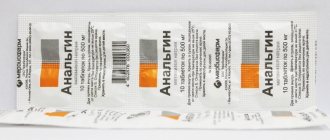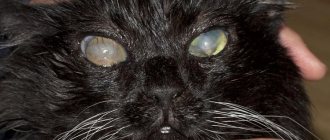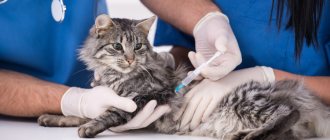What temperature is considered normal for cats?
The temperature in cats, unlike in humans, is considered normal in the range from 37.8 to 39 degrees. Higher values indicate a pathological process or overheating of the body. An increase in temperature cannot be ignored, as the cause may be a serious pathology.
Normally, a cat’s body is designed in such a way that excess heat is eliminated naturally through the skin and respiratory system. If the pet is sick, then this process of thermoregulation is disrupted.
A cat's normal body temperature is ensured by the body's natural thermoregulation.
Normal temperature values are the same for all breeds. In hairless cats, the average values also do not change.
Normal indicators
The temperature in cats, unlike in humans, is considered normal in the range from 37.8 to 39 degrees. Higher values indicate a pathological process or overheating of the body. An increase in temperature cannot be ignored, as the cause may be a serious pathology.
Normally, a cat’s body is designed in such a way that excess heat is eliminated naturally through the skin and respiratory system. If the pet is sick, then this process of thermoregulation is disrupted.
A cat's normal body temperature is ensured by the body's natural thermoregulation.
The content of the article
A cat’s temperature, like that of any other creature, is one of the main indicators of health. An elevated body temperature can be a minor overheating condition or a serious symptom. It is very important to monitor the health of the animal, because the cat cannot tell about pain or discomfort.
Normally, a cat's temperature is 38-39 degrees. Kittens have a slightly higher body temperature than adult cats. Body temperature also depends on the time of year - in summer it is higher. Sphynx cats have a high body temperature. Normally it is 41-42 degrees. In other cases, the temperature increase may be due to the following reasons.
- Simple, banal overheating. If a cat is forced to spend some time in the sun, its body temperature can rise above 41 degrees. This can happen if the cat is locked in a stuffy room or while the animal is being transported. In this case, you need to move the cat to a cool place and give it water. Usually the temperature stabilizes within a few hours.
- Sometimes cats encounter infectious diseases. If your pet, in addition to a high temperature, experiences vomiting, weakness, lack of appetite, and decreased urination, this is a serious reason to contact a veterinarian.
- Cats also get sick from viral diseases. In this case, you may experience tearing, mucus from the nose, and sneezing. In case of viral diseases, it is important to ensure high humidity in the room and give the cat enough to drink.
- High temperature may be a consequence of emotional shock. Often cats show anxiety after visiting exhibitions, the veterinarian, after moving or losing their owner. In this case, calm the animal and, if possible, bring the cat into its usual habitat. Stress fever usually goes away quickly once everything is back to normal.
- Often the body temperature rises due to the animal's physical activity. But this increase is insignificant - no more than 1 degree.
- Sometimes body temperature increases in pregnant cats due to physiological processes.
- Often, a high temperature in a cat is associated with oncology, so wondering about the diagnosis and procrastinating is a crime. Show the animal to the veterinarian and make sure there are no irreversible processes.
But sometimes it happens that the whole point is in the incorrect measurement of the animal’s body temperature.
how to make a cat vomit at home
The cat's body temperature should be measured rectally. For this purpose, the pet is pre-swaddled. It would be nice if the procedure was carried out by two people - one holds the cat, and the second measures the temperature.
Lift the cat's tail and lubricate the anus with oil, Vaseline or cream. Lubricate the tip of the thermometer as well. It is best to use an electronic thermometer, as it works quickly and gives a signal immediately after the temperature measurement is completed. But if there is no such thermometer, you can use a regular mercury thermometer.
The tip is inserted 3-4 cm into the anus with circular movements and within 5 minutes you will know the exact body temperature of your pet.
So, the cat has been diagnosed with high body temperature. It is very important here to find out the true cause of hyperthermia and respond with immediate action.
- To begin, place the animal in a cool room. Open the windows in winter, and in summer, on the contrary, turn on the air conditioner or fan.
- Place wet rollers or ice wrapped in a towel on your inner thighs and behind your ears. You can cover the animal with a wet towel.
- Provide your cat with enough water to drink.
- If the situation is urgent, and you need to see a doctor only in the morning, you can smear the cat’s paw pads with alcohol, vodka or diluted vinegar every hour.
- Under no circumstances should you wet the animal. Wet fur will be a dense barrier to thermoregulation.
- Sometimes high temperatures can cause dehydration. Especially if it is accompanied by vomiting or diarrhea. When dehydrated, a cat behaves very lethargically, sleeps a lot, and does not urinate. In this case, it is very important to water the animal to restore the salt balance. Dissolve one sachet of Regidron in a liter of water. Offer your cat to drink this mixture. If she refuses, you need to force the solution in, because dehydration is very dangerous for the cat. Wrap the animal in a diaper and use a syringe without a needle to pour the solution into the mouth.
- Some points on the animal’s body are responsible for the course of life processes. To reduce the temperature, you need to do an acupuncture massage of a point located on the back paw. On the outside of the paw, under the knee bend, massage and press the skin, and within a minute you will notice that the temperature has begun to subside. But this method is only effective if the high temperature is caused by an infection.
- During periods of elevated body temperature, offer the animal dietary and light meals, mainly liquid ones. It is best if the cat laps up chicken broth.
- If you have a fever, you can give your cat echinacea tincture. It fights infection, strengthens the immune system, and suppresses the virus. Dissolve the tincture in a small amount of water at the rate of 1 drop per 1 kg of animal weight. Pour the prepared solution into the cat's mouth with a syringe.
We suggest you familiarize yourself with: White Viennese rabbit description appearance
Remember, fever is a serious symptom. Even if you manage to knock it down, it is very important to see a veterinarian as soon as possible. Most likely, you need to fight not with temperature, but with the disease that caused hyperthermia. Take care of your animal, because it has no one to rely on except you.
how to remove fur from a cat's stomach
Having pets in the house is a big responsibility. But in addition to a good diet and leisure time for the furry pet, the owner must monitor the animal’s health. Cats, like other animals, sometimes experience troubles such as fever.
When sick, pets cannot say what hurts them or what caused the illness. The owner must take a responsible approach to ensuring a prosperous lifestyle for the pet. Loving owners always notice any deviation in the behavior of the animal, and can immediately determine that something is wrong with it. How to reduce a cat's fever at home? What should the owner know?
Healthy cats have:
- good appetite;
- shiny coat;
- wet, cold nose;
- uniform color of the mucous membranes - a uniform pink color (the shade may differ slightly in different individuals).
If a person's temperature is considered normal at 35.9 to 37.2 °C, then in a cat they are always higher - 38-39 degrees. There is an opinion that a temperature of 42 °C is considered normal for representatives of hairless breeds.
In fact, for Sphynxes it is the same as for long-haired cats. It's just that your pet's skin always feels hot when touched. It is not surprising, because there is no fur on it.
A slight increase in temperature in cats is always observed during the hot season. Indicators may vary throughout the day. So, during sleep and in the morning after waking up they are lower, but after physical activity, eating and in the late afternoon, on the contrary, they are increased. There's nothing wrong with that.
A temperature jump of 1 degree upward during estrus, pregnancy, childbirth, as well as after sterilization and vaccination should not cause concern.
It should be noted that in kittens the mechanism of thermoregulation is formed gradually. In newborns, the readings are considered normal: 35.5 to 36.5 ℃; in babies 1-2 months old, they range from 38.5 to 39.5 degrees. Once the kittens reach 7 months of age, the indicators stabilize.
An increase in body temperature in a pet can be caused by a variety of reasons. The most common of these is ordinary overheating. If the cat has been in the sun or in a stuffy room for a long time, the readings can jump up to 41 degrees.
To stabilize the temperature, it is enough to place the animal in a cool room and give it water to drink. As a rule, after a couple of hours thermoregulation returns to normal.
Temperature can also rise significantly due to stress. Cats are emotional, and the appearance of another pet in the house, moving to a new place of residence, changing or losing an owner, even a banal trip by car to the veterinary clinic causes them great anxiety.
The animal's condition will stabilize as soon as it feels that it is not in danger and its loving owner is still nearby.
Hyperthermia can be triggered by infections. In such cases, the pet experiences symptoms such as diarrhea, vomiting, urinary retention, lack of appetite, and weight loss. Infectious diseases are very dangerous and require immediate attention to a veterinarian.
If a cat's fever is accompanied by sneezing, mucous discharge from the nose, and watery eyes, it is most likely that the body is infected with a virus. In such cases, it is also necessary to visit a veterinary hospital.
The four-legged pet's temperature should be measured rectally with a thermometer. It makes no sense to measure under the paw, since all animals have hair, and the result will be incorrect.
Causes of fever in pets
When the body overheats and is stressed, the cat’s body temperature does not exceed 40 degrees. In most cases, the cause of fever can be a viral or bacterial infection that occurs in an acute form. The chronic course of pathologies is rarely accompanied by an increase in temperature. Disturbances in thermoregulation can be caused by toxins that accumulate in the body in the presence of parasites, protozoa and bacterial flora.
A cat's temperature often rises when there is a bacterial or viral infection.
The following diseases and pathological conditions contribute to an increase in temperature (hyperthermia):
- inflammatory pathologies of the ENT organs: otitis media, bronchitis, pneumonia;
- infections of the genitourinary system: cystitis, pyelonephritis;
- food poisoning;
- severe injuries;
- fungal skin infections;
- severe allergic reactions.
Processes of necrosis (death) of tissues in the body can also provoke an elevated temperature in an animal, so if there is a fever, it is necessary to show your pet to a veterinarian.
Prevention
Knowing the reasons why a cat’s temperature may rise, you can take preventive measures to avoid the development of complications. To minimize inflammatory processes and various pathologies, it is recommended to observe the following measures:
- maintain a proper diet. Animals should receive adequate nutrition, enriched with vitamins and minerals;
- regular vaccinations according to schedules;
- It is important to avoid overheating, prolonged exposure of the animal in a car, a stuffy room, or on a windowsill in the sun.
It is important for pet owners not to ignore the warning signs of fever. You cannot self-medicate, since first of all it is necessary to establish the reasons for the increase in indicators. To avoid the development of complications, when you notice the first signs of poor health in your pet, you need to take him to the veterinarian.
Additional symptoms
Fever in pets is often accompanied by apathy, lack of activity and decreased appetite. The animal may even refuse water and spend most of its time lying on its side. At the same time, the cat often hides from its owner in a secluded place where no one will disturb it.
If your pet additionally has diarrhea and vomiting, this may indicate food poisoning or acute gastrointestinal diseases: ulcers, pancreatitis and liver damage. In this case, tachycardia may also occur, the animal’s fur loses its shine and falls off.
If the pet does not allow you to touch its belly and reacts to any attempt with a plaintive meow or aggression, then this behavior indicates pathologies of the abdominal cavity.
When the temperature rises, you need to examine your pet’s skin. In the presence of sores, wounds and rashes, tick-borne encephalitis, lichen or severe allergic reactions can be suspected.
If the animal refuses water, it is important to immediately consult a doctor, as dehydration can cause death. This is especially necessary if the fever is accompanied by diarrhea.
When to contact a veterinarian
If your pet's temperature is 41 degrees, it is important to consult a doctor immediately. You can’t hesitate, otherwise the consequences can be very sad. In addition, consultation with a specialist is also important in the case when a cat has a temperature of 40 degrees, but lasts for more than a day. Immediate hospitalization is needed for fever, which is accompanied by vomiting and diarrhea. In this case, dehydration can occur in the shortest possible time and cause death.
In a clinical setting, a doctor is able to identify the cause. For these purposes, the veterinarian takes blood from the animal’s vein and also examines the skin. To eliminate bacterial and viral infections, the doctor prescribes antibiotics and immunostimulants. The most effective way to administer the medicine is by injection. It allows you to quickly eliminate the source of infection and bring down the temperature. The following are often used for therapy:
- Amoxicillin;
- Sinulox;
- Tsiprovet.
Sinulox is used to eliminate bacterial infections
To eliminate a viral infection, the following is prescribed:
- Interferon;
- Ribotan;
- Feliferon;
- Gamavit.
These drugs stimulate the body's defenses, promoting the activation of T-lymphocytes, which inhibit the proliferation of viral particles. At the end of the course of treatment, vitamin complexes and various feed additives are prescribed to speed up recovery.
Gamavit stimulates the immune system and allows you to quickly relieve your cat of fever
To reduce the temperature provoked by a severe allergic reaction, intramuscular injections of Dexamethasone are used. The dose and course of treatment are determined by the doctor depending on the severity of the symptoms. Glucocorticosteroids during fever are often administered once, as these drugs can also provoke undesirable reactions.
Dexamethasone is used to relieve allergies and fever
In rare cases, a cat is prescribed Analgin in combination with Diphenhydramine at a temperature that exceeds 41 degrees. In this case, both solutions are mixed and administered intramuscularly. Per 1 kg of weight there should be 0.01 mg of Diphenhydramine and 0.05 mg of Analgin. However, in each case, the dosage is determined by the doctor. It is not recommended to give such medications on your own.
Analgin has an analgesic and antipyretic effect
The course of treatment at high temperatures can range from 5 to 7 days, depending on the nature of the provoking factor. Viral infections require longer treatment than bacterial infections.
An increase in body temperature in cats should alert owners, as this may be a sign of a serious pathology. Home remedies can be used in combination with medication to relieve fever. However, drug therapy is not recommended without prior consultation with a doctor.
How to determine an animal's temperature
An indicator of an increase in a cat's body temperature is the nose. If it is cool and damp, then the pet is healthy. A warm and dry nose indicates hyperthermia. However, this method does not make it possible to determine accurate data. In order to measure the animal's temperature, you will need a mercury or electronic thermometer.
A cat may have a dry and warm nose, for example, after sleep. But this does not mean the pet is unhealthy. This sign should be considered in conjunction with other symptoms.
First of all, you need to prepare any available tool that will help you easily and painlessly insert the thermometer into the rectum. This could be Levomekol ointment, Vaseline or baby cream. Before the procedure, the pet should be carefully secured by wrapping it in a towel. It is good if someone helps, since it is difficult to do this on your own, especially when the cat is aggressive.
To measure temperature, you can use either an electronic or a mercury thermometer
After fixing, the tip of the thermometer must be lubricated with any of the listed products and carefully inserted into the animal’s anus to a depth of no more than 1 cm. If we are talking about a standard mercury thermometer, then you will have to wait from three to five minutes. Electronic thermometers cope with the task faster. After measuring the temperature, the device must be carefully removed from the rectum.
Measuring a cat's body temperature is done rectally
You need to insert the thermometer evenly and smoothly; such actions will avoid injury to the rectum.
Actions in case of deviation from the norm
An attentive owner will always understand that something wrong is happening to the cat: external signs that differ in hyper- and hypothermia will tell him about it.
At reduced temperatures the following are noted:
- bradycardia;
- decreased activity and lethargy;
- hypotension;
- blanching of mucous membranes;
- slow breathing, sharp inhalation/exhalation.
- trying to find a warm place.
At elevated temperatures the following are observed:
- tachycardia;
- chills and fever;
- loss of appetite and refusal to drink water;
- drowsiness and apathy;
- dehydration (with prolonged fever);
- diarrhea and/or vomiting with a bad smell (in severe cases).
In general, you should be wary of any deviations from the temperature norm, as they can signal various diseases, sometimes very serious ones.
If the elevated temperature
An increase in temperature can be caused by both diseases and other (non-physiological factors):
- viral diseases - cats usually have distemper (panleukopenia), calicivirus, rhinotracheitis and coronavirus;
- inflammatory processes - often occur when wounds or postoperative sutures become infected;
- overheating - kittens, old and weakened cats that are forced to stay in the heat for a long time, for example, in a car or in a stuffy room, often suffer from it;
- stress often provokes a failure of thermoregulation. The reasons may be a trip in transport, a visit to the veterinarian, a change of owner or place of residence.
This is interesting!
The temperature often rises by about 1 degree after vaccination, when the body produces antibodies against viruses, or sterilization (as a reaction to surgery).
Actions at elevated temperatures
If going to the vet is not possible, use the following methods to reduce the fever:
- humidify the air in the room;
- give the cat cool water (if it refuses, drink it from a syringe without a needle or pipette);
- moisten exposed skin with water;
- wrap in a wet towel;
- Place ice behind your ears, neck, or inner thighs.
Self-treatment, especially with the use of drugs developed for the human body, is not allowed. Antibiotics and antipyretics can negatively affect the cat’s body, causing allergies or liver/kidney problems.
If the low temperature
The reasons for a drop in temperature in a cat are internal pathologies and external factors, such as:
But the most common cause of a drop in temperature is hypothermia, which occurs after a cat has been in the cold for a long time.
Actions at low temperatures
If hypothermia is caused by hypothermia, your pet needs to be warmed up quickly:
- wrap in a blanket/plaid;
- place in a warm, wind-free place;
- give warm liquid to drink (you can use a pipette);
- Cover with heating pads or hot water bottles.
If your efforts are ineffective, take the cat to the hospital. There, most likely, she will be given a warm enema and put on a drip with saline solution.
Everyone knows that an increase in body temperature, both in humans and animals, is a signal for the development of the disease. Many owners do not know what to do if the cat has a temperature of 40, but in such cases they need to act quickly, otherwise the pet’s health is in danger.
Temperature is a response, a reaction of the body to the pathology that has arisen in it. He independently tries to fight the danger that has arisen, and if the forces are unequal, the temperature rises.
Each breed has its own norms, and they differ significantly. On average, the normal temperature is considered to be from 37.5 to 39 degrees. The Sphinx, with a thermometer reading of 40 degrees, feels absolutely calm and comfortable, this is quite acceptable for him. But other types of cats, with the same temperature, already need appropriate treatment.
Every owner is simply obliged to know the optimal temperature conditions for his pet in order to be confident in his health and not worry about him.
To know when it is necessary to help an animal and when not to sound the alarm, you need to know why the thermometer reading can increase in the absence of diseases
:
- simple overheating of the body. After a long stay in a stuffy, closed room, under the influence of direct sunlight, overheating may occur;
- suffered stress. Cats have a hard time being separated from their owners, long journeys, changing environments, trips to the veterinarian, attending competitions and exhibitions;
- with increased physical activity;
- the kitten, due to the fact that its body has not yet fully adapted to the environment, always has an elevated temperature;
- in pregnant cats, due to physiological processes and changes in her body, the temperature may rise;
- during meals;
- within half an hour after sleep.
Causes of increase directly related to the disease
:
The accompanying symptoms will easily help determine the main reason why the temperature began to rise.
These include
:
- tearing eyes;
- nasal discharge resembling a runny nose;
- weakness and lethargy of the animal;
- lack of appetite;
- dry and hot nose;
- vomit;
- strange, uncharacteristic behavior of the cat;
- timidity;
- cardiopalmus;
- trembling and tremors of the body;
- partial dehydration;
- diarrhea or bleeding from the anus;
- change in color of the mucous membranes of the mouth, nose and eyes;
- rapid breathing, shortness of breath, wheezing when exhaling;
- aggressiveness or complete indifference of the pet to others and treatment of it;
- your furry friend's skin may become covered with hemorrhages.
Provided that the temperature lasts for more than 48 hours in a row, the cat experiences irreversible processes in the body:
- he catastrophically loses his vitality;
- his body becomes completely dehydrated;
- when there is a lack of fluid, swelling of the brain occurs, which leads to dire consequences associated with the death of cells in the hemispheres;
- temporary or permanent paralysis of the limbs and gradually the whole body;
- heart failure.
Step 1.
Since the temperature is measured rectally, and this is not a very pleasant or desirable procedure for the animal, it is necessary to immobilize the cat. To do this, you can lightly swaddle him with a towel, so as to cover all the limbs. It will be difficult to do this alone, but it is much easier to do it together.
Step 2
. You will need a regular mercury thermometer or an electronic (it is better to take a mercury one, since the second one may have a slight error) thermometer. You need to lubricate it with greasy cream, pharmaceutical Vaseline or any oil.
Step 3
. Now we carefully insert the thermometer into the pet’s rectum, making light circular movements. You can deepen the thermometer no deeper than 2 centimeters and keep it there for 2-3 minutes.
Step 4
. We also carefully remove the thermometer.
When the temperature is high, you need to act quickly to bring it down.
In some cases there is no need to panic. If the damage is not very serious, then the animal’s body is able to fight it itself and independently bring down the temperature to 40 degrees.
Tips on how to lower your temperature at home
:
- you need to place the animal in the coolest room in the house;
- provide him with access to fresh air;
- open windows, doors;
- turn on the fan or air conditioner;
- Place ice cubes on the cat’s neck; if there are none, you can use a napkin or towel soaked in cold water. Periodically re-wet the towel;
- You can also moisten a light cloth folded in several layers with water and cover the entire furry patient with it. But, be careful, for this you need to use a light piece of fabric, for example, gauze. It is necessary to ensure that the cat does not become hypothermic;
- at a temperature of 40 in a cat, he needs to be given plenty of fluids to prevent dehydration;
- To bring down the temperature while you get to the doctor, or wait for his arrival, you can use the old proven method - lubricate the pads of all paws with a solution of vodka and vinegar. This should be done after 40-60 minutes.
You should not give your cat antipyretic drugs; they should only be prescribed by a veterinarian in accordance with the pathology. Also, it is forbidden to completely wet the animal - when the fur gets wet, air will stop flowing to the skin. This can only cause harm and seriously worsen the situation.
Many owners are thinking about whether to take their pet to the clinic or call a doctor at home. If your cat has a temperature of 40, definitely go to the clinic as soon as possible. A high thermometer reading is a symptom that is characteristic of many diseases. An animal that is very weak needs restorative treatment to support all vital functions.
With a correct diagnosis, after studying the disease, taking tests and taking all necessary measures, the doctor will prescribe therapy that will quickly get the cat back on its feet and stop all the pathological processes that were occurring in its body.
It happens that animals also need to undergo various diagnostic methods - urine and blood analysis, ultrasonic examination, x-ray. It is also permissible to involve highly specialized specialists to provide a clearer and clearer picture of the pet’s condition.
Just as an animal cannot express and complain to us about its condition, we must monitor its health and notice even the slightest changes.
If a cat has an elevated temperature and the corresponding symptoms are present, every owner is simply obliged to help him and take him to the hospital. Sometimes, it's a matter of life and death.
An elevated temperature in a cat can be a sign of a disease, stress or overheating. This symptom can be a sign of various diseases. Before resorting to any global measures, the temperature should be brought down, but done correctly.
Attention:
The normal body temperature of a cat and a human is significantly different. Optimal and healthy indicators for cats range from 38.5 to 39.5 degrees.
A slight increase in body temperature does not actually affect the general condition of the cat, as well as its daily behavior.
Often, such an ailment goes away on its own and does not require any adjustments from the owner. It's another matter when the degrees begin to skyrocket. The first signs of oppression can be observed already at a temperature of 40 degrees.
The symptoms look like this:
- lack of appetite;
- lethargy;
- drowsiness (the cat sleeps constantly);
- apathy;
- tremor;
- cardiopalmus.
Some owners determine if their pet has a high fever by feeling the nose for signs of moisture. However, this method is completely ineffective.
For example, cats' noses dry out only in the presence of very high temperatures. Also, during the sleep process, the nasal epithelium also remains dry.
Attention:
Sphynx cats have a normal body temperature of 41-42 degrees. This is due to the individual characteristics of the body of these animals and the lack of the usual coat.
What can you do at home?
If the temperature rises slightly, it is not necessary to take any measures, but even this does not cancel a trip to the doctor. If your cat has a high fever, you can use echinacea tincture, which stimulates the body's defenses. There should be 1 ml of medicine per 1 kg of weight:
- The required amount of tincture should be mixed with boiled water (1 tbsp.).
- Draw the liquid into a syringe without a needle and forcefully give it to your pet.
- It is not recommended to use the product more than once a day.
Echinacea tincture stimulates the immune system.
Additionally, you can use Regidron solution, which will replenish the fluid deficiency in the pet’s body and improve its well-being by preventing dehydration. 1 sachet needs to be filled with 1 liter of water and mixed thoroughly. The solution should be given 20 ml 3-4 times a day forcibly.
Rehydron replenishes fluid deficiency in the body
To reduce your pet's body temperature, it is not recommended to give non-steroidal anti-inflammatory medications: Ibuprofen, Nurofen, Diclofenac, etc. Such drugs can cause bleeding from the gastrointestinal tract, especially when taken on an empty stomach.
Causes of increased body temperature
The appearance of such an unpleasant symptom in a cat as a high temperature can be associated with a variety of factors. Some of them are quite harmless, and some should force you to resort to prompt actions that will correct the pet’s condition and improve its well-being.
So, a cat may develop a fever in the following cases:
- Stress and emotional overstrain
- cats by their nature are extremely emotional and impressionable animals. A long separation from the owner, the arrival of a new pet in the house, as well as moving - all these moments have a particularly negative impact not only on the psychological, but also on the physical condition of the cat. The temperature does not rise significantly. The pet may experience food refusal, a depressed and lethargic state. Typically, such a disorder goes away on its own once the cause of the stress has been eliminated. - Overheating
is a problem faced by animals that often go out on their own. Prolonged lack of fluid, as well as exposure to direct sunlight, causes the body to begin to suffer from dehydration. Also, severe overheating can occur if you leave your pet in a hot car for a long time. - Infectious disease
- any illness of an infectious nature manifests itself with an increase in body temperature. Additionally, negative signs such as vomiting, lethargy, muscle weakness, loss of appetite, and indigestion appear. - A viral disease
significantly affects the condition of the cat. Any virus quickly affects the animal’s body. Additionally, a cough appears and mucus is released from the nose. - Poisoning
- intoxication of a pet’s body with low-quality food or household chemicals is manifested not only by fever, but also by severe vomiting, as well as a complete apathetic state. The animal also breathes heavily and constantly lies down.
Attention:
Sometimes temperature can indicate the presence of cancer. In this case, only a veterinarian can confirm or refute the diagnosis by conducting a complete diagnostic examination of the pet.
Traditional methods
To reduce your pet's temperature, you can use cool water to wet the animal's paws. However, you should never bathe a cat while sick. Cool water should be used not only externally, but also given to the pet internally using a syringe every few hours, 10-20 ml to prevent dangerous consequences.
If the temperature is close to 41 degrees, then it is recommended to wipe the cat’s paw pads with vodka or alcohol (it should be diluted half with water) every hour. For the same purposes, you can use 4% apple cider vinegar diluted with water 1:1. This procedure will ease the animal’s condition and help lower the temperature slightly.
Apple cider vinegar can be used to wipe your pet's paws
In extreme heat, you can apply ice wrapped in a towel to your pet's body, avoiding the abdominal area. This product should only be used urgently. It is not recommended to use it regularly. To alleviate your pet’s condition, you can turn on the air conditioning, but only to reduce the temperature in the room by a few degrees.
Some cat breeders recommend massage to relieve fever. It is necessary to feel the area under the knee bend on the outside of the hind paw. Then massage this area for 5 minutes. This area is responsible for thermoregulation and will slightly reduce the manifestations of heat.
About medicinal properties and prohibitions
Paracetamol is considered a vital and essential medicine, according to the World Health Organization. This is a widespread analgesic that is used for therapeutic purposes to treat fever, relieve headaches, dental and postoperative pain, joint pain, and in oncology to relieve pain.
However, not so long ago there was widespread information in the press that paracetamol has many dangerous side effects, in particular liver toxicity. There is also an assumption that paracetamol increases the risk of developing diseases of the gastrointestinal tract, in particular gastric bleeding. In this regard, doctors recommend carefully monitoring the dosage of drugs containing paracetamol, and veterinarians unanimously say: paracetamol is strictly prohibited for cats!
Even if in humans it can cause liver damage, even death (statistics say that almost half of cases of liver failure are associated with an overdose of paracetamol), then in pets the liver is generally unable to break down and remove acetaminophen from the body, which causes intoxication of the body and the death of the animal .
Paracetamol (acetaminophen) is included in many medications, and all of them are prohibited for veterinary use. Such medications include:
- Paracetamol;
- Panadol;
- Efferalgan;
- Anvi-Max;
- Askofen;
- Ibuklin and others.
In small doses, paracetamol is not dangerous for humans, so these drugs are widely used in the treatment of colds and fever, but cats should not be given such medications, even in case of emergency.
A single toxic dose for cats is 50-100 mg/kg (1 tablet may contain 200 or 500 mg of paracetamol). However, intoxication of the body can occur with a much smaller dose. In veterinary practice, there have been cases of death of animals at a dose of 10 mg/kg.
First aid kit for cats and dogs
We will provide a list of medications that are recommended for a caring owner to always have with them.
For allergies:
- Cetirizine 10 mg/table.
- Prednisolone 30 mg/ml.
- Diphenhydramine or Suprastin - ampoules.
Antiseptics:
- Hydrogen peroxide solution 3% .
- Chlorhexidine solution 0.05%.
- Tricillin or Streptocide, Baneocin - powder.
- Levomekol ointment.
Antipyretic (one to choose from):
- Rimadyl.
- Flexoprofen.
- Ketofen.
These veterinary drugs are available in tablets.
Hemostatic for claw injury:
- Potassium permanganate powder (potassium permanganate).
For digestive problems: pain, nausea, constipation, diarrhea:
- Omeprazole or Kvamatel.
- Smecta.
- Activated carbon.
- Vaseline oil.
- Enterosgel.
Antidote (for Tubazid / Isoniazid poisoning)
- Pyridoxine (vitamin B6), 1% solution.
From ectoparasites:
- Drops on the withers.
- Flea collar.
- Mosquito spray.
Preparations for eyes and ears:
- Vidisik or Korneregel.
- Tobrex or Tsipromed eye drops.
- Eye and ear lotion Rosinka.
Antispasmodics and painkillers (in ampoules):
- No-shpa.
- Analgin.
From motion sickness:
- Serenia in tablets (sold only in veterinary pharmacies).
- Cerucal in tablets and ampoules.
- Espumisan - suspension or capsules.
Other:
- bandages;
- napkins;
- tourniquet;
- electronic thermometer;
- claw clipper for removing ticks - “Unicleanticktwister” or analogues: surgical clamp or tweezers;
- insulin syringes - 1, 2 and 5 ml;
- addresses of 24-hour veterinary clinics or a veterinarian’s business card.
This list of medications will help you in an emergency. But as soon as first aid is provided, you need to go to the clinic without wasting time. If your pet's condition has not improved, a visit to the doctor should be made as soon as possible. Only the veterinary clinic has additional diagnostic tools: x-rays, ultrasound, blood analyzers. After examining the patient, the doctor will prescribe additional treatment and provide qualified assistance.











